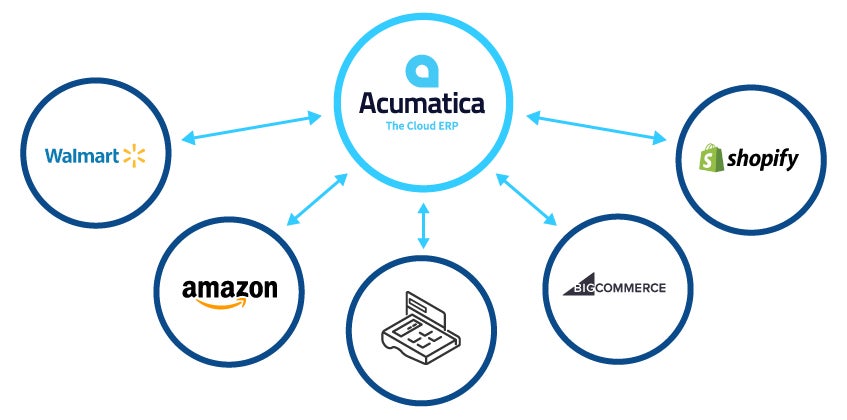What do a commerce ERP solution, SEO, and a point of sale (POS) system have in common? The success of your customers’ omnichannel retail experience.
In part two of our series on the importance of commerce ERP and SEO for retailers, we’re tackling how SEO supports the omnichannel retail experience. If you missed In the Post-Covid World, SEO is Critical for Retailers, you may want to check it out before reading further. It provides an overview of why both commerce ERP solutions and understanding SEO are important to retailers’ success.
SEO and supporting the omnichannel commerce experience
First, what is an omnichannel commerce experience? In simple terms, omnichannel commerce is offering customers multiple shopping experiences, including over the phone, online with a mobile device/laptop, or in a physical location. It also encompasses how effortlessly customers are able to move from one venue to the next while shopping or returning items.
To make the omnichannel commerce experience possible, companies can turn to commerce ERP solutions. These solutions combine commerce and retail software with a cloud ERP solution to form an integrated system. The result is a 360-degree-view of the whole business, an efficient way to store and analyze data, and the ability to optimize front-and-back-end operations (e.g., inventory, ordering, fulfillment, accounting, sales, etc.).

Once a business is set up with their website, with their commerce platform (such as Shopify or BigCommerce), and with a cloud-based business management solution to run their operations and store/analyze their data, they need the customers to visit their websites and their brick-and-mortar stores. Enticing customers is easier said than done but understanding SEO will help.
SEO is the process of getting a business’ site to show up as a top search engine result. It’s a free way for small-to-medium-sized businesses (SMBs) to draw organic traffic to their site and then, hopefully, to their physical store—or vice versa. The hardest part of SEO is that search engines, such as Google and Bing, have continuously changing algorithms for ranking sites.
According to Search Engine Journal (SEJ), “getting the key elements of SEO right can help you win clients, conversions, and sales.” Though there are many complex components to SEO, SEJ notes 11 that will help you get started. It would be good to check them all out, but for today, we’ll just note the first four:
- Know your audience and industry
- Do Keyword Research to find out what your audience is wanting
- Integrate User Intent (the variations of the keywords) into the Keyword Research
- Analyze and report SEO results
Actually, the fifth item is important, so here it is: Ensure your website works well for both mobile devices and desktop computers because of Google’s Mobile Index.
That said, let’s look more closely at the fourth item, analyzing and reporting SEO results and connect it to the importance of meeting customer expectations in-store and online.
Meeting online and in-store expectations with SEO
Meeting customer expectations is one of the most challenging aspects of running a business.
For your online business, a commerce ERP gives you the ability to balance customer needs with the day-to-day business operations. It’s integrated with your commerce platform (such as Shopify, which natively integrates with Acumatica through the aptly named Acumatica Native Shopify Integration, and BigCommerce, which integrates with Acumatica via BigCommerce: eCommerce Platform for Acumatica) can gather data from your online SEO campaign and use the built-in analytics to measure where you are (what keywords are being used most, what products/services are selling, etc.). From there, you can make changes based on customer behavior, thereby enabling you to meet continually morphing expectations.
For your in-store needs, did you know that you can incorporate SEO into your point of sale (POS) system? You can. For example, if you use a barcode scanner within your POS system, then you’re able to secure data on your in-store customers and easily get your products in front of them. One way to do this is through a product called Pointy, a business that was acquired by Google in 2020.
This is how Pointy works. You can either connect a Pointy box to your barcode scanner or download their free app if you use specific POS systems. Your products will automatically appear on your Pointy Page—no data entry required. Like SEO, this will help your store/products appear in search results, especially Google when you integrate with Google’s “See What’s in Store.”
When you combine your SEO efforts online and in your POS barcode scanner, you are well on your way to providing a seamless omnichannel experience for your customers and securing a successful future for yourself.
For merchants who want to learn more about SEO challenges and solutions, I recommend checking out solutions like Moz or Semrush.
Is Acumatica Cloud ERP your gateway to exceptional omnichannel support and growth?
One of the most important things you need to do is research your options before choosing your cloud ERP solution. Does the cloud ERP software provide a multi-channel ordering experience with an integrated retail and eCommerce option? Does it deliver a centralized view of your business for real-time status of every aspect of your retail business, from orders and inventory to shipments and profitability? And does it include an integrated and modern POS system?
Acumatica answers yes to all of these questions and more.
Taken from: In-Store to Online: How SEO Supports the Omnichannel Retail Experience – Acumatica Cloud ERP


